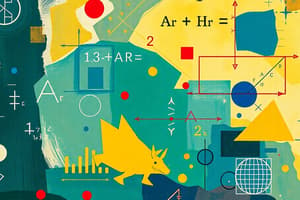Podcast
Questions and Answers
Which of the following represents the basic operations in arithmetic?
Which of the following represents the basic operations in arithmetic?
- Addition, multiplication, exponentiation, subtraction
- Subtraction, fractions, decimals, inequalities
- Addition, subtraction, multiplication, division (correct)
- Addition, multiplication, division, square root
Which type of mathematical function is represented by the equation $y = ax^2 + bx + c$?
Which type of mathematical function is represented by the equation $y = ax^2 + bx + c$?
- Linear function
- Exponential function (correct)
- Logarithmic function
- Quadratic function (correct)
What is the perimeter of a rectangle with a length of 4 units and a width of 3 units?
What is the perimeter of a rectangle with a length of 4 units and a width of 3 units?
- 24 units
- 12 units (correct)
- 14 units
- 7 units
Which trigonometric ratio is defined as the ratio of the opposite side to the hypotenuse?
Which trigonometric ratio is defined as the ratio of the opposite side to the hypotenuse?
What does the fundamental theorem of calculus relate?
What does the fundamental theorem of calculus relate?
In statistics, what is the mode?
In statistics, what is the mode?
Which of the following is a concept in set theory?
Which of the following is a concept in set theory?
What is a recommended study tip for mastering mathematical concepts?
What is a recommended study tip for mastering mathematical concepts?
Flashcards are hidden until you start studying
Study Notes
Key Areas of Mathematics
-
Arithmetic
- Basic operations: addition, subtraction, multiplication, division.
- Properties of numbers: integers, fractions, decimals, rational and irrational numbers.
-
Algebra
- Variables and constants.
- Algebraic expressions and equations.
- Functions: linear, quadratic, polynomial, exponential, logarithmic.
- Solving equations and inequalities.
-
Geometry
- Basic shapes: triangles, circles, rectangles, polygons.
- Properties: perimeter, area, volume, surface area.
- Theorems: Pythagorean theorem, properties of angles.
- Coordinate geometry: distance formula, midpoint formula, slope.
-
Trigonometry
- Trigonometric ratios: sine, cosine, tangent.
- Unit circle and its applications.
- Laws of sine and cosine.
- Angle of elevation and depression.
-
Calculus
- Limits and continuity.
- Derivatives: definition, rules, applications.
- Integrals: definite and indefinite integrals, fundamental theorem of calculus.
- Applications: area under a curve, rates of change.
-
Statistics
- Descriptive statistics: mean, median, mode, range.
- Probability: basic concepts, rules, distributions (normal, binomial).
- Inferential statistics: hypothesis testing, confidence intervals.
-
Discrete Mathematics
- Set theory: unions, intersections, complements.
- Graph theory: vertices, edges, paths, cycles.
- Combinatorics: permutations, combinations, binomial theorem.
Mathematical Skills
- Problem-solving: analysis, strategy, solution verification.
- Logical reasoning: inductive and deductive reasoning.
- Critical thinking: evaluating arguments and conclusions based on evidence.
Important Mathematical Tools
- Calculators: scientific, graphing.
- Software: MATLAB, Excel, R, Python for simulations and calculations.
- Graphs: understanding and interpreting various graph types.
Study Tips
- Practice regularly with exercises and problem sets.
- Understand concepts instead of memorizing.
- Use visual aids and diagrams for better comprehension.
- Join study groups for discussion and collaborative learning.
Arithmetic
- Foundation of mathematics, deals with basic operations: addition, subtraction, multiplication, and division.
- Explores properties of numbers, including integers, fractions, decimals, and categorizing them as rational or irrational.
Algebra
- Introduces variables and constants to represent unknown quantities.
- Deals with algebraic expressions and equations, used to model and solve real-world problems.
- Focuses on various types of functions: linear, quadratic, polynomial, exponential, and logarithmic, each exhibiting unique properties and applications.
- Emphasizes methods for solving equations and inequalities, crucial for finding solutions and understanding relationships between variables.
Geometry
- Studies properties of shapes: triangles, circles, rectangles, and polygons.
- Explores concepts like perimeter, area, volume, and surface area to measure the size and dimensions of geometric figures.
- Utilizes key theorems, such as the Pythagorean theorem, to relate angles and sides in triangles and solve geometrical problems.
- Introduces coordinate geometry, using coordinates to represent points and lines, enabling the application of algebraic methods to geometric problems.
Trigonometry
- Focuses on trigonometric ratios: sine, cosine, and tangent, representing relationships between angles and sides in right-angled triangles.
- Utilizes the unit circle, a tool for representing trigonometric functions and their properties.
- Explores the laws of sine and cosine, used to solve triangles with missing sides and angles.
- Addresses practical applications of trigonometry, including calculating angles of elevation and depression.
Calculus
- Examines limits and continuity of functions, fundamental concepts for analyzing the behavior of functions.
- Introduces derivatives to calculate rates of change and study function slopes.
- Explores integrals for calculating areas under curves and accumulating changes over time.
- Highlights the fundamental theorem of calculus, connecting derivatives and integrals.
- Emphasizes applications of calculus in various fields, including physics, economics, and engineering.
Statistics
- Deals with collecting, organizing, and interpreting data, providing insights into various phenomena.
- Utilizes descriptive statistics to summarize data using measures like mean, median, mode, and range.
- Introduces probability theory, exploring concepts like random events, probability distributions (normal, binomial), and calculating the likelihood of events.
- Incorporates inferential statistics to draw conclusions and make predictions about larger populations based on smaller sample data, using hypothesis testing and confidence intervals.
Discrete Mathematics
- Focuses on mathematical structures and concepts relevant to computer science and other fields.
- Examines set theory, dealing with sets, their elements, and operations like union, intersection, and complement.
- Delves into graph theory, studying networks of vertices and edges, analyzing properties like paths, cycles, and shortest routes.
- Explores combinatorics, analyzing arrangements and selections of objects, utilizing concepts like permutations, combinations, and the binomial theorem.
Mathematical Skills
- Essential for solving mathematical problems, including analyzing the problem, developing strategies, and verifying solutions.
- Emphasizes logical reasoning, applying inductive and deductive reasoning to solve problems and draw valid conclusions.
- Promotes critical thinking, evaluating arguments and conclusions based on evidence, ensuring logical and sound reasoning.
Important Mathematical Tools
- Calculators, both scientific and graphing, aid in calculations and solving complex equations.
- Software like MATLAB, Excel, R, and Python provide tools for simulations, data analysis, and complex mathematical operations.
- Graphs play a pivotal role in visualizing data, relationships, and trends, facilitating comprehension and analysis.
Study Tips
- Regular practice with exercises and problem sets is crucial for strengthening understanding and building proficiency.
- Focus on understanding core concepts rather than simply memorizing formulas or procedures.
- Utilize visual aids and diagrams to enhance comprehension and visualize mathematical concepts.
- Collaborate with peers in study groups for discussion, sharing insights, and solving challenging problems together.
Studying That Suits You
Use AI to generate personalized quizzes and flashcards to suit your learning preferences.




